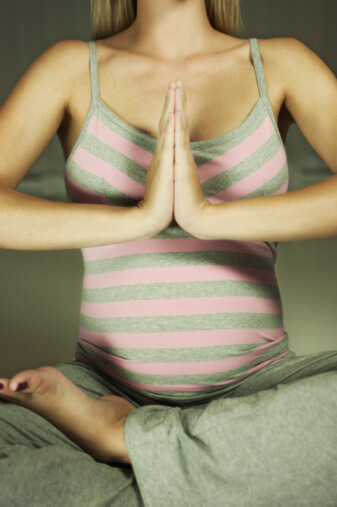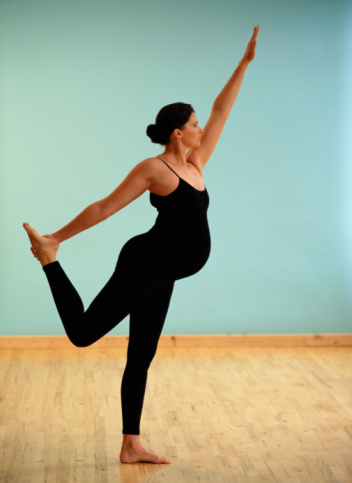
Pregnancy is an exciting time but let's face it, it can be a bit overwhelming too. When I found out I was pregnant with my daughter, I was overjoyed. Being a yoga teacher as well as a yoga student, I realized this was the time that it would be crucial for me to continue to include yoga into my daily life. Yoga was the best thing I could do for myself and my baby. I needed yoga to keep my body strong and flexible especially because this is a time that we carry more weight and have hormones jumping all over the place.
Prenatal Yoga helps women work on strength, endurance, flexibility, balance and stability, while focusing on breath and relaxation; this will of course help make labor and delivery easier. (not easy, but easier.) Yoga helps us learn how to, and remember to breathe, something that is not always easy when a woman is trying to balance life with a baby growing inside her.
Below are explanations of some of the benefits of yoga for the pregnant body. I enjoy yoga so much and know that when I am consistent with my practice, even if it is just for fifteen minutes at the end of the day, it really helps me reconnect with my body and my beautiful child growing inside me. I encourage all moms-to-be to try to do a little bit at a time, just to slow down and give yourself a moment of “me time.” By practicing yoga, you will find it helps to combat fatigue, backache, digestive disorders, and headaches that may or may not come at some point in your pregnancy.
These energizing poses strengthen your body, open your abdominal area and chest as well as extend your spine. Your spine bears the load of your uterus while pregnant, which is why you should do standing poses. In general, standing poses strengthen your abdominals without putting pressure on the fetus. Some women do find standing for a long time difficult towards the latter part of their pregnancy, if that is the case use a wall for support and don’t stay in the pose past what’s comfortable.
These postures extend your spine, take pressure off your lower back, lengthen your hamstrings, improves circulation to your legs, kidneys, and pelvis as they relax your pelvic floor muscles, increase your energy and realign spine. Always come out of the pose slowly so that you don’t get dizzy and always keep your legs at least hip-width apart.
If you already do backbends in your practice, you can continue them safely through your first trimester. Supported backbends help to tone your anterior spinal muscles and stretch the muscles of your anterior abdominal wall and diaphragm to accommodate the growth of your uterus.
Seated poses can help to relieve lower back pain. They help to stretch the pelvic floor, release stiffness in your lower back, hips, groin, and knees, and stimulates blood flow to your kidneys.
Prenatal yoga is about creating space for the baby to move and grow, so generally speaking twisting poses that compress the abdomen should be avoided after the first trimester. A simple seated twist might feel good to someone in their first trimester to relieve lower back pain, helping to increase fresh blood flow.
You can practice inversions as long as it is comfortable for your body. Usually women in their seventh or eight month stop doing them, but some women do stop sooner. If you’re not comfortable doing these in your fourth month, by all means eliminate it from your practice. Inversions release tension in your neck, shoulders, and spine; lifts your uterus off your pelvic floor so you don’t feel the heaviness you feel right side up, stimulates your endocrine system, and refreshes the blood flow. A great inversion for a pregnant woman would be Legs-Up-the-Wall Pose (Viparita Karani) with a bolster under your sacrum.
With a consistent practice, yoga will provide tools to help fight common ailments while pregnant. By stretching, bending, and squatting, muscles will release and lengthen allowing the breath to flow with movement and in-turn calms any fears and anxieties while improving blood flow.
If you are new to yoga, or haven’t tried it yet, try to find a prenatal class. A prenatal instructor won’t recommend poses for you that are uncomfortable or dangerous and they can help make sure you are doing the poses safely.
✬ After the first trimester, limit or avoid doing poses on your back because it may reduce your blood flow to the baby, avoid any positions in which you lie on your belly, postures that contract your abdominal muscles, deep twists, and anything that just doesn’t “feel” right- listen to your body.
✬ Don’t force anything. Remember that the hormone relaxin is coursing through your body right now, so your body might be more vulnerable to strains and sprains.
✬ In your final trimester, you may need to use a chair or wall nearby for standing poses. This might not apply to everybody, but your center of balance may not be as great as it was so using a chair or wall will help steady yourself.
✬ Remember to breathe.
✬ Always consult with your physician before beginning (or continuing with) any physical regimen.
Enjoy the journey of pregnancy and experience the joy and connection yoga can give you on and off the mat.
